And by that I mean everything!!! In D&D, nothing is safe!
Continue reading “Fantasy Safari: Everything is trying to kill you!”
Yora's site for Sword & Sorcery RPGs
And by that I mean everything!!! In D&D, nothing is safe!
Continue reading “Fantasy Safari: Everything is trying to kill you!”
The Moatia are a race of short old men with yellow skin who walk with a limping gait. All of them are powerful sorcerers who live alone deep within the forests and warn away any intruders with markposts made from bones. They are often wicked and cruel, but are also very skilled healers who have medicine and powders to cure any ailment in existance. They never provide services for free though, and the prices they demand can be very steep or appaling. Moatia don’t use any weapons or attack with their hands, but fight entirely with their magic. They remind me quite a lot of central European witches in their behavior and role.
The Night Men are a race of humans from outside the Three Lands, but all of them are savage and deformed, but almost nothing is known about them other than that they sometimes cross the river at night and raid villages on the southern border. When they attack, they always do so in large hordes, and are usually led by a very powerful sorcerer or shaman. These raiders destroy villages and take large numbers of captives, which they take back to their jungles to be sacrificed in ancient ruined temples. Some people think that they are evil spirits or actually animals that have been transformed into human-like shapes.
The Obia is a spirit in the shape of a large leopard or jackal that serves sorcerers and witches as a guardian or to abduct people and bring them to them. Either to become their wives or for other unspeakable purposes. An obia can grasp a victims in its mouth without hurting them and then run off into the night at very great speed leaving barely any traces. Only the greatest hunters have any chance of tracking them down and find the place where the victims are held. Defeating the sorcerer and his obia guardian is a whole different story altogether.
Continue reading “Fantasy Safari: Spears of the Dawn, Part 2”
I reviewed Spears of the Dawn a few weeks ago, and it’s a nice little setting I recommend to anyone with interest in non-European influenced fantasy campaigns. I also really love the new classes and magic system based on Basic D&D that work much better for spellcasters in a Sword & Sorcery setting than standard clerics and wizards. But in addition to all that, Spears of the Dawn also has a short and very nice collection of monsters, which made me want to make another Fantasy Safari post.
As part of the funding campaign, all the art from the book was given away freely, which is always very nice when doing this series.
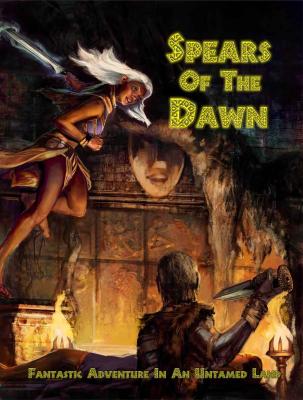
Spears of the Dawn by Sine Nomine Publishing, 2013; 11 pages of monsters.
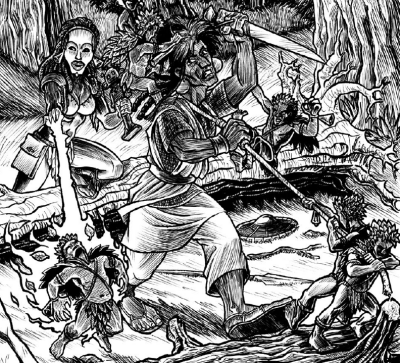
Eloko are a race of tiny people who look just like humans but have grass instead of hair and wear clothes made from leafs. However, there is nothing endearing about these little guys, as they like to eat humans. Lone hunters are a welcome meal for groups of eloko, but they have a particular taste for the flesh of women. Before they reveal themselves to their prey, they make their presence known by the ringing of tiny bells, which have the ability to cloud the thoughts of any human to the point where they will simply stand around motionless while being devoured alive. If someone can resist the mind numbning ringing of their small bells, eloko are still much more dangerous than their small size makes them look and a single one fights about as well as a fully grown crocodile. In groups they can be a real threat to small parties of adventurers.
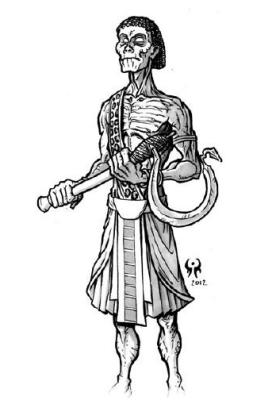
The Eternal are probably my favorite monster of Spears of the Dawn and the major antagonists of the setting. When their evil kingdom was facing defeat by the five other realms of the Three Lands, they turned to dark magic to make themselves immortal. After their death, a magic ritual made their bodies return to a state of unlife, where they need to neither eat, drink, sleep, or even breath. Nor do they bleed and they are impossibly to truly destroy. Stabbing wounds don’t harm them at all and the only way to really harm them is to break their bones or chop off their limbs. While they are able to exist deep in the deserts or underground without any food or water forever and can not be killed by weapons, their unliving nature also makes them unable to heal as they are still corpses. The only way to restore their mangled bodies after suffering the effects of injuries, blasting sand, and the blazing sun is to feed on human flesh. And that already tells you pretty much everything you need to know to understand why they are such a terrifying menace on the Three Lands. They are a lot like vampires in many ways, but also distinctively different creatures. They do not have to feed on humans, but if they do not the ravages of time and the environment quickly take a heavy toll on their dead flesh. They are not harmed by sunlight and in fact nothing can really destroy them. The only way to deal with them permanently is to decapitate them so they are unable to feed and heal their injuries, but even when burned to ash and their bones are ground to dust, their immortal spirits remain, unable to gain a new body or truly die. And like vampires, many eternal sorcerers know the old rituals and can raise the corpses of their enemies to be their slaves forever. Spears of the Dawn is an interesting setting in itself, but the Eternal are what really is selling it to me. They are somewhat similar to an idea I had for my Ancient Lands settings, and I got a whole number of new ideas I want to include from the Eternal. Continue reading “Fantasy Safari: Spears of the Dawn, Part 1.”
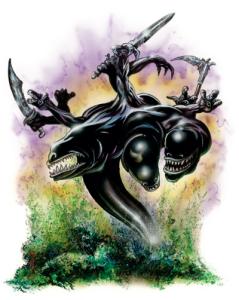
The phaerimm were weird, but the Sharn are even weirder. They are large black creatures with three eyeless heads and three arms that each end in three hands with three fingers and an eye in each palm. Like that phaerimm, they are powerful sorcerers but also clerics and they can create three small portals through which they can stick their hands to cast spells at targets behind walls, around corners, or similar situations. To make things worse, sharn are always under the effect of the haste spell, which under the rules version of this book allows them to cast two spells every round. Not surprisingly, these creatures are so alien that they are immune to any magic that manipulates their minds or changes their bodies. A somewhat unusual quirk is that no magic can change the shape of another creature to look like a sharn. Why that is the case seems to be simply an oddity of the universe. While the sharn are both very weird and alien, they are thankfully not really evil and they also hate the phaerimm. In fact it was the sharn who created the magical barrier that trapped the phaerimm under the Anauroch desert. These guys are some really trippy stuff. They first appeared with the phaerimm in the sourcebook Anauroch, which I didn’t know was actually written by Ed Greenwood himself. It’s strange that they have such a tiny presence in the Forgotten Realms. I only ever saw them in this monster book and the Return of the Archwizards novels, which are about the return of the Netherese Empire from the Plane of Shadow, which got the phaerimm all rilled up.
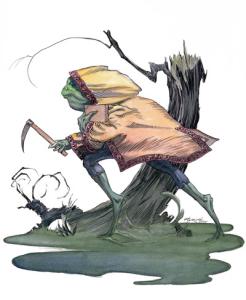
The Sivs are a race of frog people similar to the classic bullywugs, but also very different. While bullywugs are primitive savages, the sivs are as smart as humans and usually Lawful Evil, and even have training as monks. I’m not sure if there’s a kung-fu toad style. They also have the ability to run on the surface of water, which is very kung-fu indeed. It all looks like a quite intriguing idea, but sadly there isn’t really any useful description to how they behave and what they want.
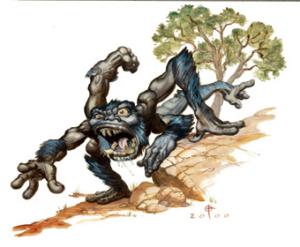
The Tall Mouther is classic old-school D&D weirdness. It’s a big head with a big maw and six arms, covered in blue fur. Otherwise it’s a bit like an ogre and especially loves to eat halflings.
Continue reading “Fantasy Safari: Monsters of Faerûn (D&D 3rd Ed.), Part 5”
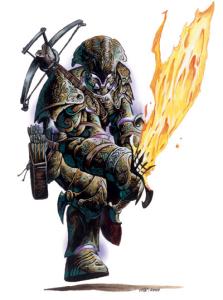
The Helmed Horror is probably one of my favorite monsters of my favorite monster book. I first saw these guys in Baldur’s Gate back in ’99, and they were terrifyingly strong. Good times. On first glance, the helmed horror is simply an animated suit of armor. But like many monsters in this book, it’s made into something much more interesting by giving it a small handful of magic abilities. Compared to true golems, it is relatively weak. But golems in Dungeons & Dragons are absolute terror beasts, so this guy is still amazingly dangerous. The main ability of a helmed horror is that it can make the blade of any weapon it holds burst into flame, covered in magic ice, or charged with lightining. It really only increases its damage by 1d6 points of damage, but it’s still an impressive looking effect that immediately tells everyone they mean business. They can also see any invisible creatures, which makes them great guardians for wizards. In addition to being made of full plate armor and difficult to hit, they are also have all the immunities of constructs and are enchanted to be completely immune to three specific spells. Usually those will be classic attack spells like fireball or lightning bolt, and while casting a spell that affects everything in a large area on a single enemy is not particularly effective, there aren’t that many other spells that can really hurt helmed horrors to begin with. As constructs, they are already immune to almost all illusions, enchantments, and necromancy spells. Disabling a helmed horror other than by hacking it to pieces is quite the challenge. Fot added fun, it also has the spells air walk and feather fall, which make it almost impossible to use the terrain against it. Pits and barriers won’t stop it at all, and even though being a heavy suit of armor, a helmed horror is just as fast as any ordinary human. It’s a fucking Terminator.
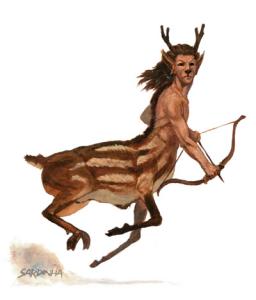
The Hybsil is one of the rare fey creatures in D&D 3rd edition, which for some reason never got much love beond the dryad, nymph, pixie, and satyr. Hybsils look like a small deer with the upper body of a small human or halfling with short antlers on their head. Though individually they are quite weak and vulnerable, they usually live in groups of several dozens and their high speed combined with their reliance on bows and arrows can make them formidable opponents. They also have the magical abilities to move without leaving any tracks and to greatly increase the distance of their jumps, which makes them amazingly well suited for ambushs. For emergencies, they also have a few magical sleep arrows they get from pixies, which can knock out many enemies instantly. They are also lead by druids and have their own rangers and sorcerers, which makes things a lot more complicated for any potential attackers. Picking a fight with any hybsils in their forest homes is much more dangerous than it looks from seeing just one or two of these small creatures.
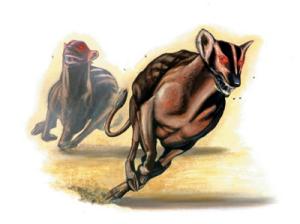
The Leucrotta is a dangerous predator based on sketchy descriptions of hyenas by the Romans. This creature simply runs with it and is exactly what was described. It has the body of an antelope, the tail of a lion, and the head of a badger, It is as large as a horse and has jaws that can even bite through armor. Leucrottas are intelligent creature and completely evil and violent. They simply live for killing. Quite surprisingly to many people, they also can talk and are very capable of immitating the voice of other animals and even people. These guys are some really viscious murder machines and that they are very able at climbing and jumping doesn’t make things better for anyone. Continue reading “Fantasy Safari: Monsters of Faerûn (D&D 3rd Ed.), Part 4”
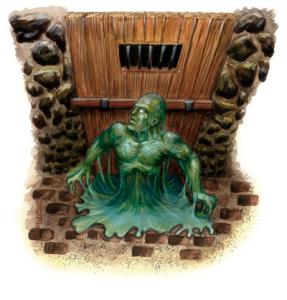
The Ghaunadan is a slime creature very much unlike any other in Dungeons & Dragons. In addition to being an ooze, it also is a shapechanger that can take the form of any kind of humanoid. It is also far from mindless like other oozes and instead a highly intelligent creature. It’s slime has a paralysis effect on living creatures and it also can easily disarm enemies by pulling their weapon into its body. A ghaunadan also has a limited form of charming gaze, which gives it a significant boost to all Charisma checks against a creature it has charmed, which makes ghaunadans excelent for infilitrating humanoid cities and palaces. Ghaunadans are associated with the ancient and evil god Ghaunaur, who rules over slimes and all kind of weird Underdark creatures and is sometimes worshiped by drow. Since all his traits are basically the same in every way as those of the demon lord Juiblex, I always consider them to be actually the same being. I don’t remember seing any hint of ghaunadans in any works older than this book, so it’s quite likely that they were inspired by the Shapechangers from Star Trek: Deep Space Nine, who are mostly the same thing but can also take the shape of objects and nonhumanoid creatures.
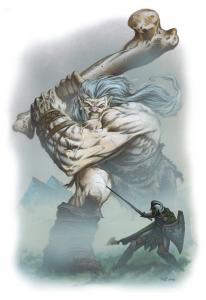
I can’t really say anything about the Fog Giant, other than it’s a giant without special abilities who ranks in power between a stone giant and a frost giant, but is taller than either. But look at this picture! When this guy hits you, you’re paste!
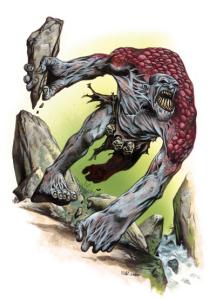
The Phaerlin Giant is a creature native to the Phaerlin region of the Underdark in the Forgotten Realms, which lies under the huge Anauroch desert and was once the location of the mighty wizard empire Netheril, but is under control of the phaerimms (more on those later). Phaerlin giants look like slightly mutated stone giants and live entirely underground, which I think is a neat idea. Reminds me of grimlocks. But their stats in this book are pretty wonkey. They are probably the only creature in D&D that is size category Huge and has a Challenge Rating of 3. Like any self respecting Underdark creature they have magic resistance and being primitive and feral they can sense nearby creatures by scent. Almost 70 hit points is also nothing to laugh at, but their backs are bent so badly that they move only very slowly. And for some unexplained, but nonmagical reason, they are so terrifying that characters who fight them have to make a saving throw or suffer penalties to all their attacks and saves because of fear. This is usually an ability reserved for the most powerful beasts and inhuman abominations. Here it just seems out of place. I like the cave giant from Pathfinder a lot more. Continue reading “Fantasy Safari: Monsters of Faerûn (D&D 3rd Ed.), Part 3”